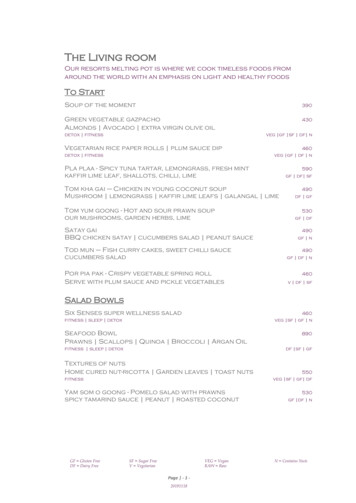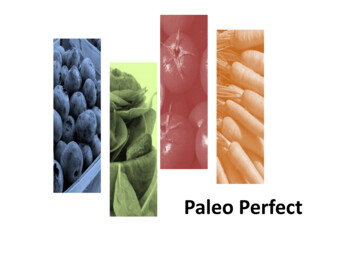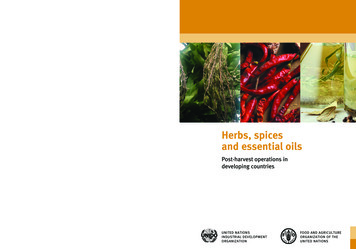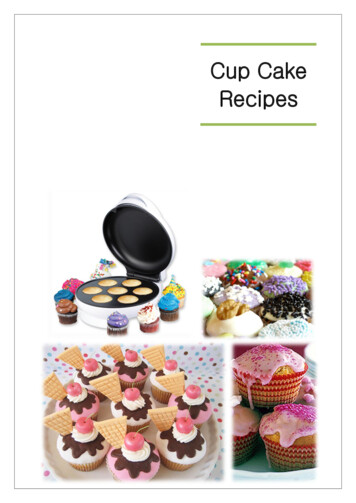
Transcription
iSTUDY OF VANILLA ESSENTIAL OIL EXTRACTION: HEAT AND WAVEPRINCIPLESNUR FARHANA GHAZALIA thesis submitted in fulfillment of the requirements for the award of the degreeof Bachelor of Chemical EngineeringFaculty of Chemical & Natural Resources EngineeringUniversity College of Engineering & Technology MalaysiaNOVEMBER 2006
vABSTRACTTo extract an essential oil the method used is extraction without using organicsolvent. The conventional method used is hydro distillation (HD) that applies heatprinciple. However, a new green technique for essential oil extraction that is microwavewhich is applies wave principle was developed in recent years. Solvent-free microwaveextraction (SFME) is a combination of microwave heating and dry distillation performedat atmospheric pressure without added any solvent or water. SFME with presence ofcarbonyl iron powder (CIP) was compared with HD for the extraction of essential oilfrom vanilla (Vanilla planifolia) with different type of raw material sizing. SFMEextracted essential oil with higher value of percentage yield and concentration whichallowed substantial savings of costs in terms of time, energy and plant material. SFMEis an environmental friendly technique as it was rejected less carbon dioxide (CO2)compared to HD technique. The strength of aroma of extracted essential oil from bothmethods was compared by calculating the degree of concentration. The loss of thearoma depends on the degree of concentration. By using high performance liquidchromatography (HPLC) system the presence on vanillin in the extracted oil wasidentified and has been compared in terms of presence of impurities quantity andconcentration. Vanilla treated by SFME and HD were viewed by scanning electronmicroscopy (SEM) and the results reveal that vanilla structure treated by SFME wasbeing more ruptured compared to conventional HD technique.Keywords: Essential oil; Vanilla planifolia; Vanillin; Solvent-free microwave extraction(SFME); Hydro distillation (HD).
CHAPTER 1INTRODUCTION1.1Background of studyVanilla beans are the fruits of Vanilla planifolia Andrews that is the group ofOrchidaceae. The curing of green vanilla beans to obtain the well-appreciated vanillaaroma is a very laborious process. Every vanilla cultivating country has developed itsown curing process but it generally consists of four steps that are scalding, sunning orsweating, drying and conditioning. Usually, scalding is followed by an autoclaving step.This means that the beans that have become hot after scalding are put into an airtightcontainer overnight to retain as much heat as possible. It can be regarded as the firstsweating step. The whole process normally takes more than 6 months (Dignum et al.,2002).Vanilla planifolia has opposite, sessile leave of 10 to 23 cm long which areoblong in shape. Vanilla is a climbing plant whose stems may grow up to 30 m long. Ithas aerial roots that it sticks to the tree that serves it as support. It has fleshly leaves andlarge blackish-ochre pods with many seeds (Roger, 2002).The curing of green vanilla beans to obtain the well-appreciated vanilla aroma isa very laborious process. The highest grade of cured vanilla is Black vanilla and thelowest grade is Red vanilla (Loeillet, 2003).
2Vanilla has stomachic, digestive and choleretic that increase the bile secretion,mildly invigorating and aphrodisiac properties. Although it’s present use is only as aseasoning it is worth remembering its invigorating benefits to the digestive functions(Roger, 2002).Figure 1.1Vanilla beansThe main component of the vanilla aroma is vanillin (4-hydroxy-3ethoxybenzaldehyde) which was first isolated and identified in vanilla by Gobley et al,1858. In the green bean important phenolic aroma compounds are present as glucosides.The curing process is meant to release the aglycons to set free the aroma compounds. Inthe last century, considerable research was devoted to the vanilla curing process. Manyexperiments have been conducted to determine the optimal conditions to obtain a goodquality of cured vanilla, the important compounds and enzymes that are involved(Dignum et al., 2002).
3Figure 1.2VanillinVanillin is obtained from sulfite waste liquor by further alkaline hydrolysis oflignin. The same substance can be obtained from vanilla bean extract and is thecommon flavoring in foods and drinks. Natural and synthetic vanillin can bedistinguished from each other by a slight difference for 13C in their structure since oneis biosynthetic in the bean and the other is isolated from a second natural product, woodand hydrolysis from the lignin (Speight, 2000).Natural vanilla is one of the most widely used and important flavoring materialsworldwide. The source of vanilla is the bean or pod of the tropical Vanilla orchid that isprincipally Vanilla planifolia Andrews, synthetic V. fragrance. The Aztecs of Mexicocultivated Vanilla which was then brought to Europe by the Spaniards after 1520 and isnow cultivated in a number of tropical countries. The major producers are Mexico,Madagascar, Tahiti and Indonesia. Vanillin in fact occurs in trace amounts in otherplants including commercial products such as tobacco. However, the pods of theVanilla orchid remain the only commercial source of natural vanillin (Walton et al.,2003).A new technique to extract essential oils is microwave extraction that applieswave principle was developed in recent years. Solvent-free microwave extraction(SFME) is a combination of microwave heating and dry distillation performed atatmospheric pressure without adding any solvent. Microwave heating has already beenwidely applied in solvent extraction because of its main advantages like rapidity and
4high efficiency. SFME performed at atmospheric conditions without adding any solventor water provided a new idea in the extraction of volatile compounds from fresh plantmaterials or prior moistened dried material. Besides, it made the whole process to bemore simple, rapid and economic. Many scientists had applied SFME in extractionsfrom aromatic herbs and spices (Wang et al., 2005).1.2ObjectiveThe objective of this research is to study the solvent-free extraction of vanillaessential oil through hydro distillation and solvent-free microwave extractiontechniques.1.3ScopesThe scopes of this study are:1. To study the effect of raw material sizing based on presence of vanillin inextracted product from HPLC analysis.2. To study the effect of raw material sizing based on extracted productconcentration.3. To study the effect of raw material sizing based on strength of aroma bycalculating the product degree of concentration.4. To study the energy consuming based on extraction time and electrical power.5. To study the environmental effect by calculating CO2 rejected.6. To study the vanilla structural changes by using Scanning Electron Microscopy(SEM).
51.4Problem statementsVanilla has very high demand and prices in the world for it’s popular uses inflavoring ice creams and soft drinks. However, there is limited research on vanillaextraction in the world. Vanilla is also used in production of soaps, body lotions, floorpolishes, air-fresheners, detergents, perfumes, cakes and pharmaceutical products.Vanilla essential oil extraction industry has a big potential to grow up inMalaysia. At this moment, there is no vanilla essential oil extraction industry inMalaysia. Malaysia import the vanilla extracts from other country such as Indonesia forfood manufacturing industry. This country is at tropical region and has hot climate assame as climate at Indonesia which is one of the largest and popular producer of vanillain the world. Malaysia also safe from bad disaster such as hurricane. Hurricane atMadagascar in 1999 was destroying about 35% of the crop and 15% of the stocks.Even though vanilla is quite expensive, the extraction of vanilla can yield notmore that 5% of essential oil. Besides, the solvent extraction also not really safe forhuman health because it uses organic solvent such as methanol, ethanol, hexanol andothers. It can cause hepatitis and kidneys malfunction. Solvent extraction also requiredhigher cost of extraction because the uses of organic solvent.The demand for increasingly clean and efficient chemical synthesis iscontinuously becoming more urgent from both an economic and an environmentalstandpoint. So-called green technologies are looking for alternatives yet they focus onlarge quantities of hazardous even toxic solvents. One could ever say that the bestsolvent is no solvent. Conventional method of extractions that are hydro and steamdistillation that applies heat principle are the common methods that are always used.The methods will yield many impurities in the essential oil extracted, needs long periodof extraction and yield the low strength of aroma. However, a new green technique toextract essential oils that applies wave principle that is solvent-free microwaveextraction was developed in recent years that make the extraction simpler and save
6energy. The technique will yield better quality of essential oil aroma, higher percentageyield and reduce the number of impurities to be volatized during the extraction. Besides,this technique prevents solvent wastes, hazards and toxicity.
CHAPTER 2LITERATURE REVIEWConcentrated vanilla extracts have attained popularity with the manufacturingtrade because they are cheaper than standard vanilla extract. There is true economy in ause of a concentrated extract because of the appreciable saving in alcohol and providedthe concentrated product retains the full strength and quality of flavor of the beans fromwhich it was made (Dignum et al., 2002) .2.12.1.1Essential oils and oleoresinsEssential oilsAn essential oil is a concentrated and hydrophobic liquid containing volatilearomatic compounds extracted from plants. It may be produced by distillation,expression or solvent extraction. Essential oils are used in perfumery, aromatherapy,cosmetics, incense, medicine, household cleaning products and for flavoring food anddrink. They are valuable commodities in the fragrance and food industries. The
8essential oil has been obtained by steam distillation while the oleoresin is producedusing solvent extraction (Povh et al., 2001)Essential oils are mainly formed by hydrocarbon and oxygenated terpenes and byhydrocarbon and oxygenated sesquiterpenes. They can be extracted from seeds, roots,flowers, herbs and leaves using the hydro distillation technique. This is a very simpleprocess but suffers of many drawbacks such as thermal degradation, hydrolysis andvolatilization in water of some compounds that alter the flavor and fragrance profile ofmany essential oils extracted by this technique (Reverchon and De Marco, 2006).Essential oil is also known as volatile oil and ethereal oil. It may also be referredas oil of the raw plant material from which it was extracted such as oil of clove. Theterm essential is intended to convey that the oil is an essence of the plant it is extractedfrom. It is not in the more common sense of being indispensable and do not confusethem with essential fatty acids. The conventional methods used for the preparation ofessential oils and spice oleoresins are steam distillation and solvent extractionrespectively (Simandi et al., 1998).The essential oils of plants have usually been isolated by either hydro distillationor solvent extraction. The disadvantages of all these techniques are low yield, losses ofvolatile compounds, long extraction times, toxic solvent residues, degradation ofunsaturated compounds and giving undesirable off-flavor compounds due to heat(Mostafa et al., 2004).2.1.2OleoresinsResin is a hydrocarbon secretion of many plants valued for its chemicalconstituents and uses such as varnishes and adhesives. The term is also used forsynthetic substances of similar properties.
9Vanilla oleoresin is a semi-solid concentrate obtained by removing the solventfrom the vanilla extract. A solution of isopropanol is frequently used instead of ethanolfor the preparation. Some flavor and aroma is lost during removal of the solvent but itdoes contain essential oils. Vanilla oleoresin is used in non-food products.Unfortunately, it is not always stable in candle and soap making as it is considerably lessexpensive than vanilla absolute.Vanilla oleoresins are employed as a base for the manufacture of flavors andhave been articles of commerce for many years but the literature on flavoring materialsindicates that food officials have given little attention to the detection of theiradulteration (Wilson and Sale, 1926).2.22.2.1Other raw materials of essential oil extractionPatchouliPatchouli is both a plant and an essential oil obtained from the leaves of thatplant. The scent of patchouli is heavy and strong. Many people find it offensive. It hasbeen used for centuries in perfumes. Patchouli grown in the East and West Indies.Patchchouli is a word derives from the Tamil patchai means green and ellai means leaf.Patchouli oil and incense underwent a surge in popularity in the 1960s and 1970smostly among devotees of the free love and hippie lifestyles as it covers up the scent ofmarijuana. The Hare Krishna movement may have been responsible for this surge as thegod Krishna was said to “inhabit” patchouli. Besides, it can be used as a hairconditioner for dreadlocks.
10Despite its common association with an alternative lifestyle patchouli has foundwidespread use in modern industry. It is a component in about a third of modern highend perfumes including more than half of perfumes for men. Patchouli is also animportant ingredient in East Asian incense. It is also used as a scent in products likepaper towels, laundry detergents and air fresheners. The essential oil is obtained bysteam distillation of the dried leaves of the plant. Steam distillation is a process thatprovides a relatively high yield of the oil. An important component of the essential oil ispatchoulol.During the 18th and 19th century silk traders from China traveling to the MiddleEast packed their silk cloth with dried patchouli leaves to prevent moths from layingtheir eggs on the cloth. Many historians speculate that this association with opulenteastern goods is why patchouli was considered by Europeans of that era to be aluxurious scent. This trend has continued to the present day in modern perfumery.The patchouli plant is a bushy herb reaching two or three feet in height. Theplant grows well in southern climates. It enjoys hot weather but not direct sunlight. Ifthe plant withers due to lack of watering it will recover well and quickly once it has beenwatered. The seed-bearing flowers are very fragrant and bloom in late fall. The tinyseeds may be harvested for planting but they are very delicate and easily crushed.Cuttings from the mother plant can also be rooted in water to produce further plants(Roger, 2002).2.2.2LavenderThe lavenders Lavandula are a genus of about 25 to 30 species of floweringplants in the mint family Lamiaceae. It is native from the Mediterranean region south totropical Africa and east to India. The genus includes annuals, herbaceous plants,subshrubs and small shrubs. The native range extends across the Canary Islands, north
11and east Africa, south Europe and the Mediterranean, Arabia and India. Because thecultivated forms are planted in gardens worldwide they are occasionally found growingwild as garden escapes.Lavender is one of the most useful medicinal plants. Commercially the lavenderprovides several important essential oils to the fragrance industry including soaps,colognes, perfumes, skin lotions and other cosmetics. In food manufacturing, lavenderessential oil is employed in flavoring beverages, ice cream, candy, baked goods andchewing gum. The essential oils of Lavandula species are obtained by steam distillationof the fresh flowering spikes. Oil quality is assessed by oil chemical composition and bythe organoleptic opinion of the flavorists (Chemat et al., 2005).Lavenders are widely grown in gardens. Flower spikes are used for dried flowerarrangements. The fragrant, pale purple flowers and flower buds are used in potpourris.Dried and sealed in pouches, they are placed among stored items of clothing to give afresh fragrance and as a deterrent to moths. The plant is also grown commercially forextraction of lavender oil from the flowers. This oil is used as an antiseptic and foraromatherapy.Lavender flowers yield abundant nectar that yields a high quality honey forbeekeepers. Lavender honey is produced primarily in the nations around theMediterranean and marketed worldwide as a premium product. Lavender flowers can becandied and are used as cake decoration (Roger, 2002).2.2.3CymbopogonCymbopogon that is also called as lemon grass, lemongrass, citronella grass orfever grass is a genus of about 55 species of grasses, native to warm temperate andtropical regions of the Old World. It is a tall perennial grass.
12Lemon grass is widely used as an herb in Asian and Caribbean cooking. It has alemony flavour and can be used fresh, dried and powdered. The stalk itself is too hardto be eaten except for the soft inner part. However, it can be finely sliced and added torecipes. It may also be bruised and added whole as this releases the aromatic oils fromthe juice sacs in the stalk. The main constituent of lemongrass oil is citral.Lemon grass is commonly used in teas, soups, and curries. It is also suitable forpoultry, fish and seafood. It is often used as a tea in African countries.The East-Indian lemon grass (Cymbopogon flexuosus) is native to India, SriLanka, Burma, and Thailand while the West-Indian lemon grass (Cymbopogon citratus)is assumed to have its origins in Malaysia. While both can be used interchangeably,Cymbopogon citratus is more suited for cooking. In India, Cymbopogon citratus is usedboth as a medical herb and in perfumes (Roger, 2002).2.2.4OrangeSweet orange is refers to the citrus tree Citrus sinensis and its fruit. The orangeis a hybrid of ancient cultivated origin possibly between pomelo (Citrus maxima) andtangerine (Citrus reticulata). It is a small tree, growing to about 10 m tall with thornyshoots and evergreen leaves 4 to10 cm long. The word "orange" comes from Sanskrit"narang". Oranges originated in Southeast Asia in either India, Vietnam or southernChina. The fruit of Citrus sinensis is called sweet orange to distinguish it from Citrusaurantium that is the bitter orange.Oranges are widely grown in warm climates worldwide and the flavors of orangevary from sweet to sour. The fruit is commonly peeled and eaten fresh or squeezed forits juice. It has a thick bitter rind that is usually discarded, but can be processed intoanimal feed by removing water using pressure and heat. It is also used in certain recipes
13as flavoring or a garnish. The outer-most layer of the rind is grated or thinly veneeredwith a tool called a zester to produce orange zest. It is popular in cooking because it hasa flavor similar to the fleshy inner part of the orange. The white part of the rind, calledthe pericarp or pith is a source of pectin (Roger, 2002).2.2.5Ylang-ylangYlang-ylang or Cananga odorata is the flower of the cananga tree. The treeattains an average height of 12 meters grows in full or partial sun and prefers the acidicsoils of its native rainforest habitat. The leaves are long, smooth and glossy. The floweris greenish yellow or pink, curly like a starfish and yields a highly fragrant essential oil.The word derives from the Tagalog plant name ilang-ilang that means flower offlowers and does not allude to the pleasant scent of ylang-ylang flowers.The fragrance of ylang-ylang is rich and deep with notes of rubber and custard,and bright with hints of jasmine and neroli. The essential oil of the flower is obtainedthrough steam distillation of the flowers and separated into different grades according towhen the distillates are obtained. The main aromatic component of ylang-ylang ismethyl anthranilate.Ylang-ylang essential oil is used in aromatherapy where it is believed to relievehigh blood pressure, normalize sebum secretion for skin problems and considered to bean aphrodisiac. The oil from ylang-ylang is widely used in perfumery for oriental orfloral themed perfumes. Ylang-ylang blends well with most floral, fruit and woodsmells. In Indonesia, ylang-ylang flowers are spread on the bed of newlywed couples(Roger, 2002).
142.2.6 GinsengGinseng (Panax Ginseng) root has been continuously used for more than 4,000years in China due to its invigorating properties. It was introduced in Europe during theeighteenth century and has bees the issue of many scientific studies due to itsextraordinary virtues. Its scientific name Panax comes from the Greek words pan that ismeaning of all and axos that is meaning of healing. For Chinese people, Ginseng is atrue panacea that is able to heal a wide range of afflictions. Its aphrodisiac effects havegiven it a wide popularity in Western countries in which tobacco, alcohol and otherdrugs have become a continuous aggression to sexual performance.The active components of ginseng root are so chemically complex that it has notbeen possible to synthesize them up to now. They are called ginsenosides andchemically these are steroid glycosides from the group of triterpenic saponins.Therapeutic properties of ginseng are due mainly to these subtances but are alsoenhanced by other components that are minerals and trace elements, sulphur,manganese, germanium, magnesium, calcium, zinc, vitamin B complex, phutosterol andenzymes.Ginsenosides increase physical performance and endurance. This is not due toany excitant properties such as cocaine, coffee, tea or other drugs but to an improvementof metabolic processes. Ginseng speeds up the enzymatic process of glycogenesis that isthe production of glycogen on the liver from sugar and glycogenolysis that is productionof sugar from the stored glycogen decreases the concentration of lactic acid in musclesthat causes stiffness.Ginseng promotes spermatogenesis, stimulates sexual glands and increaseshormone production. It increases sexual capability, improving both frequency andquality of male erection and promoting female genital organs excitation. Ginseng alsopromotes mental performance, increasing concentration and memory capabilities. Otherthan that, ginseng has anti-stress properties due to its adaptogenic properties, because it
15increases adaptation capabilities of the body to physical and psychological efforts.Research conducted on animals has proven that both hypophysis and suprarenal glandsare stimulated with ginseng (Roger, 2002)2.3VanillaVanilla is the only edible fruit of the orchid family that is the largest family offlowering plants in the world. It is a tropical orchid and there are about 150 varieties ofvanilla though only two types, Bourbon and Tahitian that are used commercially.2.3.1Types of Vanilla2.3.1.1 Bourbon beansBourbon beans are long and slender with a very rich taste and smell. Bourbonbeans have thick oily skin containing an abundance of tiny seeds and have a strongvanilla aroma. Bourbon beans from Madagascar and the Comoros are described ashaving creamy, hay like and sweet with vanillin overtones. Bourbon beans from otherregions will be similar if they are picked at peak ripeness and are properly cured.2.3.1.2 Mexican beansMexican beans are very similar to Bourbon beans though they have a mellower,smooth and a spicy, woody fragrance.
162.3.1.3 Tahitian beansTahitian beans are usually shorter, plumper and contain a higher oil and watercontent than Bourbon beans. The skin is thinner and they contain fewer seeds. Thearoma is fruity and floral. It often described as smelling like licorice, cherry, prunes orwine (Kroschwitz and Grant, 1997).2.3.2VanillinVanillin is a natural product that can be found as a glucoside that is glucovanillinin vanilla beans at concentrations about 2%. It can be extracted with water, alcohol orother organic solvents. Vanillin was observe long before it was reported in chemicalliterature as it crystallizes on the surface of vanilla beans after harvesting, processingand storage. The first report in the literature was probably made by Bucholtz in 1816.Some years later, Bley referred to vanillin from alcoholic solutions of vanilla beanextract and succeeded in obtaining it in a relatively pure form. He reported itscomposition to be C10H6O2. Its correct analysis that is C8H8O8 was established in 1872by Carles who gave its correct melting point that is 81oC.Vanillin being an aldehyde is able to form acetals and hemiacetals. Therefore, inflavor formulations using high concentration of vanillin in conjunction with carrierssuch as propylene glycol, a glycol analysis often shows a reduced vanillin peak afterstorage of the compound flavor and the presence of new peaks indicating acetalformation. Addition of about 0.5% of water to the formula reverses the reaction forexample there is a reduction of acetal and the reappearance of vanillin peaks(Kroschwitz and Grant, 1997).
172.3.3Properties of vanillinTable 2.1: Properties of ecular Weight152.15Chemical FormulasC8H8O3AppearanceWhite to light yellow crystalsOdorPleasant odorSolubilitySoluble in 125 parts waterSpecific Gravity1.056pHNo information foundPercentage Volatiles by volume or 21oC0(70F)Boiling Point285oC (545oF)Melting Point81oC to 83oC (178oF to 181oF)Vapor Density (Air 1)5.2Vapor Pressure (mm Hg)0.0022 or 25oC (77oF)Evaporation RateNo information foundStabilitySlowly oxidizes in moist air and lightsensitiveHazardous Decomposition ProductsCarbon dioxide and carbon monoxide mayform when heated to decompositionHazardous PolymerizationWill not occurIncompatibilitiesStrong oxidizers
182.3.4Uses of vanilla2.3.4.1 Food flavoring compoundsAt least 30% of food-grade vanillin consumed in the world is through flavoringcompounds. Flavoring compounding requires expertise to develop well-balanced andcomplex flavors such as fruit flavors. In the industrial production of dry cookies, cakesand pastries, the vanillin content ranges between 20 and 50 g per 100 kg of dough.Vanillin also is added during the chocolate manufacturing process in powder form inaverage amount of 20 g per 100 kg of the finished product. Although the vanillinconcentration is a matter of taste depending on different factors in each individual casethe following concentrations are generally accepted.Table 2.2: Accepted vanillin concentration for dark chocolate and milk chocolateVanillin flavoringg/100kgDark chocolate15-60Milk chocolate5-30In confections, the main applications are sugared almonds, caramel, nougat andsweets. For sugared almonds and caramel, vanillin is mixed into the sugar in the dryphase of the recipe. For nougat, vanillin is added during the liquid phase ofmanufacturing. In sweets, vanillin is added in the form of a 10% ethanol solution. Thefollowing may serve as a rough guide.Table 2.3: Accepted vanillin concentration for various productsVanillin flavoringg/100 kgSoft-center sweets5-15Other sweets15-30Caramel15-55Chewing gum15-45Nougat40-55
19The main application of natural vanilla is for flavoring ice creams and softdrinks. It is estimated that nearly 300 tonnes of vanilla beans is used in USA every yearin the preparation of cola type drinks. The major industrial purchasers of vanilla arepharmacy companies and soft drink companies like Coke and Pepsi. However, the factremains that market for natural vanilla essence is today largely only confined to theWest. There is no market in India now for vanilla essence. The domestic market inIndia is restricted to the green vanilla beans. In India, processing companies buy greenvanilla beans from the farmers to process it and then export the same to foreign buyerswho then do the extraction of vanilla essence (Kroschwitz and Grant, 1997).2.3.4.2 Animal feedVanillin is used as a palatability enhancer to make animal feed more appetizingby flavor-masking minerals with off-taste. Approximately 5 g of vanillin/100 kg of feedis added when preparing feed for lambs and pigs in order to increase feed intake andstimulate the growth of the animals. Vanillin is added during the manufacturing processeither by mixing into the dry ingredients or in its liquid form. Increasingly vanillin isalso used as a substitute for aniseed (Kroschwitz and Grant, 1997).2.3.4.3 Perfumes and cosmeticsIn aldehylic perfumes, vanillin provides the powdery impressions given by thebackground smell usually up to 2% in the perfume concentrate. In fruity notes, vanillinenhances the fruity for instance a peach is not fully peach without vanillin. Whenvanillin is combined with some floral notes such as heliotrope and orchid that actuallycontain strong vanilla impressions, amounts of 2 to 5% are possible. However, withnotes such as rose, orange flower and jonquil the addition of 0.1 to 2% vanillin can bringwarmth and elegance. In woody families such as fougere and in spicy perfumes theharsh impression also needs the fine and smooth aroma provided by vanillin traces. In
20detergent perfumes, the stability of vanillin is not always certain. It depends on theassociation made with other raw materials such as patchouli, frankincense, cloves, mostof the animal notes and such chemicals as amyl salycate, methyl ionones and oakmosses. In some cases, these mixtures can cause discoloration effects. In cosmetics asin bath products most of the problems arising with the use of vanillin are related to thesoap perfumery problems. The amount of perfume concentrate used in bath products isusually lower than that used in fine fragrances. Vanillin is also useful as a deodorant tomask the unpleasant odor of many manufactured goods. As a masking agent fornumerous types of ill-smelling mass-produced industrial products particularly those ofsynthetic rubber, plastics, fiberglas
2.1 Essential oils and oleoresins 2.1.1 Essential oils An essential oil is a concentrated and hydrophobic liquid containing volatile aromatic compounds extracted from plants. It may be produced by distillation, expression or solvent










